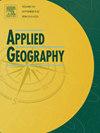21世纪以来中国土地利用和土地覆盖变化对濒危脊椎动物的差异影响
IF 5.4
2区 地球科学
Q1 GEOGRAPHY
引用次数: 0
摘要
土地利用/土地覆盖变化(LUCC)一直被认为是生物多样性丧失的主要驱动因素。然而,自2000年以来,中国经历了快速的经济增长,导致土地利用模式发生了重大变化。这些进程正在深刻影响《昆明-蒙特利尔全球生物多样性框架》的实现,但其影响尚不清楚。本研究旨在通过整合多阶段高分辨率土地利用/土地覆盖数据集和生物多样性数据集,识别受土地利用/土地覆盖变化影响的潜在生物多样性点(特别是耕地扩张、城市化和生态恢复)。我们发现445点威胁脊椎动物物种丰富度高的潜在威胁农田扩张,主要在东北和空长江平原,和421位扩建定居点和威胁的脊椎动物物种丰富度高,集中在空长江平原和南部中国。生态修复工程规模大、濒危脊椎动物物种丰富度高的景点有296处。由于不同分类类群的空间分布,受威胁的哺乳动物和两栖动物从生态恢复项目中获益最多。相反,鸟类从生态恢复项目中受益最少。研究结果有望为中国实现《昆明-蒙特利尔全球生物多样性框架》的目标提供科学参考。本文章由计算机程序翻译,如有差异,请以英文原文为准。
Differential influence on threatened vertebrates under land use and land cover change in China since the 21st century
Land use/land cover change (LUCC) has been considered a primary driver of biodiversity loss. However, since 2000, China has experienced rapid economic growth, leading to significant shifts in land-use patterns. These processes are profoundly impacting the achievement of the Kunming-Montreal Global Biodiversity Framework, yet their influence remains unclear. Here, we aim to identify the potential biodiversity spots affected by LUCC (particularly cropland expansion, urbanization, and ecological restoration) by integrating the multiple phases of high-resolution land use and land cover datasets and the biodiversity dataset. We found that 445 spots with high species richness of threatened vertebrates are potentially threatened by cropland expansion, mainly in the Northeast China and the Middle-Lower Yangtze Plain, and 421 spots characterized by settlement expansion and high species richness of threatened vertebrates, concentrated in the Middle-Lower Yangtze Plain and the South China. There were also 296 spots, characterized by large-scale ecological restoration projects and high species richness of threatened vertebrates. Due to the spatial distribution of different taxonomic groups, threatened mammals and amphibians have benefited most from ecological restoration projects. Conversely, birds benefited the least from ecological restoration projects. The findings are expected to provide scientific references for China to achieve the goals of the Kunming-Montreal Global Biodiversity Framework.
求助全文
通过发布文献求助,成功后即可免费获取论文全文。
去求助
来源期刊

Applied Geography
GEOGRAPHY-
CiteScore
8.00
自引率
2.00%
发文量
134
期刊介绍:
Applied Geography is a journal devoted to the publication of research which utilizes geographic approaches (human, physical, nature-society and GIScience) to resolve human problems that have a spatial dimension. These problems may be related to the assessment, management and allocation of the world physical and/or human resources. The underlying rationale of the journal is that only through a clear understanding of the relevant societal, physical, and coupled natural-humans systems can we resolve such problems. Papers are invited on any theme involving the application of geographical theory and methodology in the resolution of human problems.
 求助内容:
求助内容: 应助结果提醒方式:
应助结果提醒方式:


